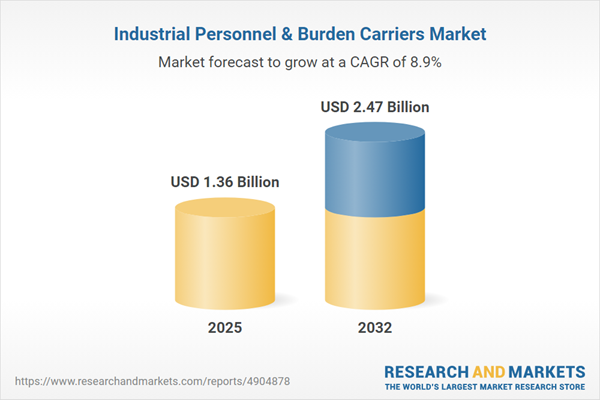Speak directly to the analyst to clarify any post sales queries you may have.
The industrial personnel and burden carriers market is rapidly transforming, catalyzed by a convergence of automation, sustainability mandates, and shifting regulatory landscapes. Senior leaders in warehousing, logistics, and manufacturing face critical decisions as advanced carrier solutions reshape operational strategy, risk management, and competitiveness.
Market Snapshot: Industrial Personnel & Burden Carriers
In 2024, the industrial personnel and burden carriers market was valued at USD 1.25 billion and is projected to reach USD 1.36 billion by 2025. The sector is forecast to continue its robust expansion at a CAGR of 8.85%, ultimately achieving a market size of USD 2.47 billion by 2032.
Scope & Segmentation
This report provides a detailed analysis of the market, expertly segmenting by technology, application, region, and end-user requirements. The following areas are comprehensively covered to guide strategic investment and operational planning:
- Product Types: Automated guided vehicles, forklift trucks, pallet jacks, reach trucks, stackers, and tow tractors. Each type serves specific operational roles, from high-density fulfillment to cross-dock applications.
- Propulsion Types: Electric (including both lithium-ion and lead-acid systems), hybrid, and internal combustion engines powered by diesel, gasoline, or liquefied petroleum gas. The landscape is shifting towards electric and hybrid models, driven by performance and compliance needs.
- Capacity Ranges: Less than 5 tons, 5 to 10 tons, and above 10 tons. Each category aligns with unique load profiles, spanning compact warehouse operations to heavy manufacturing and bulk handling.
- Operation Modes: Autonomous, pedestrian operated, remote operated, and rider operated vehicles support varying levels of automation and control, catering to different safety and workflow requirements.
- End-User Industries: Automotive, food and beverage, retail, manufacturing (including automotive OEMs, chemical, and food processing), and warehousing and distribution. Each brings tailored specifications and compliance priorities.
- Regional Coverage: Americas, Europe, Middle East & Africa, and Asia-Pacific, with in-depth insights into major and emerging sub-regions, reflecting divergent supply chain, compliance, and demand drivers.
Key Takeaways: Strategic Insights for Decision Makers
- Industrial personnel and burden carrier solutions now serve as fundamental enablers of operational resilience, supporting increased throughput and mitigated workplace risks within modern logistics environments.
- Advanced telematics and real-time data integration empower organizations to monitor performance, anticipate maintenance needs, and reduce downtime—ultimately leading to greater service reliability and safety.
- Labor shortages and stringent workplace safety standards have amplified demand for ergonomically designed, automated solutions, which actively help minimize injury risks and improve workforce productivity.
- Customization is increasingly vital; organizations are strategically balancing mixes of automated, electric, and traditional vehicles to match evolving workflows, throughput demands, and regulatory frameworks.
- Servitization and collaborative partnerships, such as bundled maintenance and operator training, are redefining vendor relationships and revenue stability for market leaders.
United States Tariff Impact
Recent US tariffs on imported materials and finished vehicles have challenged supply chains, pushing manufacturers to reconsider sourcing, embrace domestic assembly, or diversify vendor bases. Strategic alliances between OEMs and local suppliers are gaining traction, serving as buffers against cost volatility and logistical bottlenecks. As a result, firms are adopting agile procurement models and, where suitable, increasing buffer stocks or initiating reshoring to maintain supply security and mitigate operational risks.
Methodology & Data Sources
This research utilizes a robust methodology, blending qualitative executive interviews with comprehensive secondary data analysis from industry publications and governmental documents. Directional shifts and emerging trends were validated through standardized triangulation of customs, manufacturing, and logistics data, complemented by expert peer reviews and scenario sensitivity testing.
Why This Report Matters
- Delivers actionable intelligence for C-suite leaders seeking to navigate fast-evolving market dynamics and optimize capital allocation.
- Supports supply chain, operations, and plant managers in benchmarking technology adoption and forging resilient procurement strategies.
- Equips organizations to proactively address regulatory compliance, sustainability goals, and ongoing technological disruption within the industrial personnel and burden carriers sector.
Conclusion
Technological progress, regulatory change, and policy trends are realigning strategies and investments for industrial carriers. Leaders leveraging this intelligence will be better positioned to drive resilience, efficiency, and growth in a demanding global marketplace.
Additional Product Information:
- Purchase of this report includes 1 year online access with quarterly updates.
- This report can be updated on request. Please contact our Customer Experience team using the Ask a Question widget on our website.
Table of Contents
3. Executive Summary
4. Market Overview
7. Cumulative Impact of Artificial Intelligence 2025
Companies Mentioned
The companies profiled in this Industrial Personnel & Burden Carriers market report include:- Toyota Motor Corporation
- KION Group AG
- Jungheinrich AG
- Hyster-Yale Materials Handling, Inc.
- Mitsubishi Logisnext Co., Ltd.
- Crown Equipment Corporation
- Komatsu Ltd.
- Doosan Industrial Vehicle Co., Ltd.
- Hangcha Group Co., Ltd.
- BYD Company Limited
Table Information
| Report Attribute | Details |
|---|---|
| No. of Pages | 198 |
| Published | October 2025 |
| Forecast Period | 2025 - 2032 |
| Estimated Market Value ( USD | $ 1.36 Billion |
| Forecasted Market Value ( USD | $ 2.47 Billion |
| Compound Annual Growth Rate | 8.8% |
| Regions Covered | Global |
| No. of Companies Mentioned | 11 |









